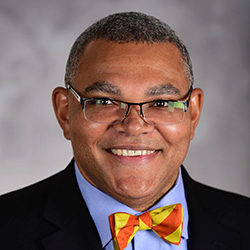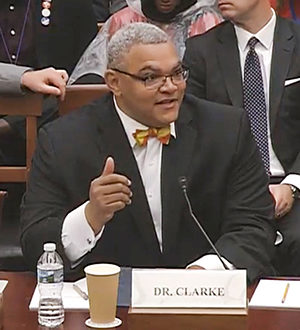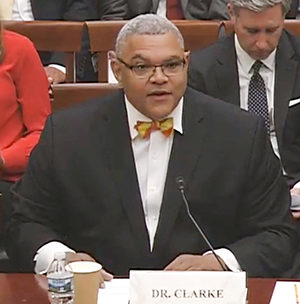 Aerospace engineering professor J.P. Clarke, second from the left, is seen here waiting to testify before the Congressional Committee on Space, Science, and Technology on July 24. Check out this video of the entire hearing.
Aerospace engineering professor J.P. Clarke, second from the left, is seen here waiting to testify before the Congressional Committee on Space, Science, and Technology on July 24. Check out this video of the entire hearing.
Imagine a city where vertiports outnumber bus stops, traffic jams are a rarity, and a cross-town taxi ride gives you a great aerial view of the setting sun. Are they cars that fly or aircraft that can take a corner? That's the world that the Congressional Committee on Science, Space, and Technology was envisioning July 24 when they asked Georgia Tech aerospace engineering professor Dr. John-Paul Clarke to give testimony on the promise and the challenge of urban air mobility (UAM). Clarke's extensive teaching, scholarship, and research give him a unique and compelling perspective on the work that needs to be done to make UAM a reality. His testimony, reprinted here, serves as an elegant primer on the possibilities that lay ahead.
 |
| Prof. J. P. Clarke |
Chairman Smith, Ranking Member Johnson and Members of the Committee:
Thank you for the opportunity to comment on the potential benefits and challenges of Urban Air Mobility (UAM). I am a College of Engineering Dean’s Professor at the Georgia Institute of Technology, where I have a joint appointment in the School of Aerospace Engineering and the School of Industrial and Systems Engineering, and am Director of the Air Transportation Laboratory. Of further relevance to my testimony, I was Co-Chair of the 2014 National Research Council Committee on Autonomy Research for Civil Aviation. That said, I should note that while my testimony is informed by my participation on that Committee, I am speaking as an individual today.
Overview
UAM is a logical response to the perennial quest for speed in congested urban areas. In the latter half of the 19th century, we satisfied this need for speed in cities such as London and New York by going underground. In the early 21st century, when surface and underground transportation modes are reaching their limits, and the costs of additional infrastructure are prohibitive, we are seeking to satisfy this need for speed by moving to the air. Rather than focus on the speed and other benefits afforded by UAM, I would like to focus my remarks on the challenges that need to be overcome, and the research that must be conducted to enable UAM.
The subject vision for UAM is that of Vertical Take-Off and Landing (VTOL) or Short Take-Off and Landing (STOL) aircraft transporting people directly (i.e., on non-stop flight segments) from their origin to their destination. However, there is an equally compelling vision of VTOL aircraft transporting packages and cargo on non-stop flight segments between their origins and destinations. If both visions are fully realized, there will certainly be a great many aircraft flying along roads and between buildings in the urban setting—more so because a point-to-point service network requires significantly more aircraft than a hub-and-spoke network.
 My sense is that UAM will ultimately involve the movement of both people and cargo between their origins and destinations, and it will very likely also require a dynamic hub-and-spoke network, i.e., where flight segments and the location of hubs are dynamically generated based on demand to achieve the desired economies of scale. With this vision as a basis for analysis, it is evident to me that:
My sense is that UAM will ultimately involve the movement of both people and cargo between their origins and destinations, and it will very likely also require a dynamic hub-and-spoke network, i.e., where flight segments and the location of hubs are dynamically generated based on demand to achieve the desired economies of scale. With this vision as a basis for analysis, it is evident to me that:
1. Aircraft will require greater autonomy.
If the most-optimistic growth scenarios are realized, and at least one operator is required in each aircraft, we won’t be able to train the requisite numbers of operators to the typical skill level of pilots. Further, from the perspective of commercial operations, there is a forecast shortage of commercial pilots, and the economies of scale do not support the employment of multiple operators or operators that are trained and thus compensated at the same rates as commercial pilots. Thus, both passenger and cargo aircraft must be designed for both autonomous operation (i.e., without continuous human participation or supervision) and autonomous decision-making (i.e., able to determine what to do next in an unscripted situation without needing to consult a human) if they are to have a single operator or operators with significantly less training than commercial pilots.
If, on the other hand, aircraft are operated remotely, there could be time delays between the operator and the aircraft (due to the distance between them) and periodic loss of communication (due to line of sight blockage by buildings). Periodic loss of communication is especially problematic when aircraft are operating near each other, near people and objects on the ground, and in an environment with rapidly changing wind conditions (due to wind gusts generated by buildings). Thus, remotely operated aircraft must also be designed for both autonomous decision-making and autonomous operations.
 2. The two basic aspects of Air Traffic Management (ATM), i.e., Air traffic control (ATC) and Traffic flow management (TFM) will require greater autonomy.
2. The two basic aspects of Air Traffic Management (ATM), i.e., Air traffic control (ATC) and Traffic flow management (TFM) will require greater autonomy.
If the most optimistic growth scenarios are realized, ATC—the detection and resolution of potential conflicts—will not be possible via human command and control because, when significant numbers of vehicles are operating in a constrained and rapidly changing environment, conflict detection and resolution must be conducted more precisely and rapidly, and will at the very least require automated systems that can operate autonomously. In addition, the number of air traffic controllers required to accommodate a large fleet of UAM aircraft would not be affordable. Further, because the automation cannot simply hand ATC over to a human when faced with a situation that was not considered when it was designed, the automation must also be capable of autonomous decision-making.
Separately, TFM—the forecasting and regulation of the number of aircraft entering a specific volume of airspace—will not be possible with human-in-the-loop decision-making. At an airport, there is airspace available for airborne holding and remote areas on the surface to hold and park aircraft. At an urban/metropolitan vertiport, there is less airspace available for airborne holding, and few or no remote areas on the surface to hold or park aircraft. During periods of high traffic demand, the scheduling and management of vertiport arrivals and departures must be more precise and timely than currently possible, and will also require automated systems that can operate autonomously.
3. The proliferation of vertiports will raise noise, privacy, and safety concerns.
In most visions for UAM, aircraft are either helicopters or propeller-based aircraft that use their propellers to achieve VTOL, and they take-off from and land at locations near where people “want to be,” e.g., near their homes. Locations near the homes of passengers and the recipients of packages will also be near the homes of other residents who might not be as receptive to noise emanating from rotating blades/propellers. Further, the proximity of the aircraft to windows and backyards is likely to raise issues with respect to privacy, and in virtually all locations there willbe concerns with respect to safety.
4. Vertiport locations and flight trajectories must be jointly optimized for efficiency, noise, privacy,and safety.
The noise generated by helicopters, and other aircraft that use propellers to achieve VTOL, is dominated by the shock waves from the tips of the rotating blades, and blade vortex interaction (BVI) the additional noise that is generated when a propeller blade moves through the wake from another propeller blade. Noise in general can be reduced by moving the noise source further away from the receiver, and/or by shielding the receiver from direct exposure to the noise source, e.g., by placing the vertiport behind or between buildings where no noise-sensitive activities are conducted. BVI can be reduced by optimizing the arrival (descent) and departure (ascent) trajectories. Thus, joint optimization of vertiport locations and flight trajectories can play an important role in reducing community objections to UAM operations based on noise.
Joint optimization of vertiport locations and flight trajectories can also play an important role in terms of efficiency, privacy, and safety. With regards to efficiency, the energy and time expended during arrival and departure is a function of the distance to the vertiport and the trajectory flown.
So too are the distances to and the ability to observe activities in the homes of other residents. With regards to safety, consideration and analysis of post-failure operations is a critical part of aviation. Fixed-wing aircraft are only allowed to take-off after the pilot (or dispatcher) has shown via computation that they can either abort or continue to take-off after one engine has failed.
Commercial aircraft are only allowed to fly on a given route after it has been determined that the aircraft type in question will be able to land at an airport if one engine were to fail at any point along that route. Thus, given the proximity of these aircraft to each other, and to people and objects on the ground, accident risk must also be considered when determining the locations of vertiports and designing flight trajectories.
5. ATM for UAM will likely be provided by private/municipal entities that are monitored/regulatedby the FAA.
If the history of aviation is a guide, air traffic operations in each urban/metropolitan area will be managed independently of operations in other urban/metropolitan areas. Further, in the case of UAM, where for the most part it is envisioned that the new VTOL aircraft will use lower operating altitudes and different airspace than conventional aircraft, it is very likely that regions within an urban/metropolitan area will be managed independently. While it certainly is possible to expand the operational side of the FAA to provide ATM services for UAM, it seems more likely, given the enthusiasm for UAM, that some sort of public-private partnership will be formed between private and municipal entities, and that the FAA will play a regulatory role.
6. Legislation may be needed with respect to certification requirements for vehicles, systems, andoperators.
Manufacturers of aviation vehicles and systems, and the operators of these vehicles and systems, receive an implicit, and in some cases, explicit reduction in liability once they have completed lengthy and rigorous evaluations, and have satisfied very stringent certification requirements. While shorter evaluation periods would be beneficial with respect to enabling the envisioned growth in UAM, there may be negative implications with respect to liability. Thus, careful consideration must be given to how best to reduce certification requirements and time commitments without imposing onerous liabilities on manufacturers and operators.
The first two issues I have raised relate to autonomy. The third and fourth issues relate to modeling and optimization. The fifth and sixth are public policy issues, for which I am not an expert. Thus, I will confine the remainder of my remarks to the research challenges and objectives for autonomy research,and for modeling and optimization research.
Autonomy Research
In the 2014 NRC report entitled “Autonomy Research for Civil Aviation—Toward a New Era of Flight” my colleagues and I identified eight technical barriers, four regulation and certification barriers, and twolegal and social barriers to increased autonomy in civil aviation. Paraphrasing the wording from thatreport, these barriers are:
Technology Barriers
- Excessive demand for data and communications bandwidth
- Vulnerability to cyber-physical attacks
- Need for backward compatibility with diverse legacy vehicles
- Need for humans and machines to work together in new and different ways
- Lack of generally accepted methods for “handling” adaptive/nondeterministic systems
- Limited machine sensing, perception, and cognition capabilities
- High system complexity and low resilience (thereby allowing failures in one part of the system to easily propagate throughout the system)
- Insufficient methods for verification and validation
Regulation and Certification Barriers
- Unmanned aircraft requiring a certificate of authorization to operate in non-segregated airspace
- Certification criteria and processes that do not consider the characteristics of advanced autonomy
- Safety standards and requirements that are not well suited to unmanned aircraft operations
- Inability to engender trust in adaptive/nondeterministic increasingly autonomous systems
Legal and Social Barriers
- Public policy (i.e., law and regulation) impeding the degree and speed of adoption of autonomy
- Public concerns about privacy and safety impeding the degree and speed of adoption of autonomy
While we did not individually prioritize these barriers, we did identify four barriers that were particularly onerous with respect to meeting the key challenge, which is “How can we assure that advanced increasingly autonomous systems—especially those systems that rely on adaptive/nondeterministic software—will enhance rather than diminish the safety and reliability of the National Airspace System?”
We also proposed the following four “most urgent and most difficult” research projects:
- 1. Develop methodologies to characterize and bound the behavior of adaptive/nondeterministic systems over their complete life cycle.
- Develop the system architectures and technologies that would enable increasingly sophisticatedand increasingly autonomous systems and unmanned aircraft to operate for extended periods of time without real-time human cognizance and control.
- Develop the theoretical basis and methodologies for using modeling and simulation to accelerate the development and maturation of advanced, increasingly autonomous systems and aircraft.
- Develop standards and processes for the verification, validation, and certification of increasingly autonomous systems and determine their implications for design.
I believe that these research projects remain relevant to the quest for increasingly autonomous vehicles and systems, and are relevant to the realization of UAM. To my knowledge, NASA has started research ineach of these four areas. However, progress has been slow, and needs to be accelerated.
Modeling and Optimization Research
Helicopter noise has been and continues to be a concern in urban areas. This is evident in New York City—where helicopter route changes have been made to address noise concerns and the City has mandated a 50% reduction in air tour flights in 2016 (after proposing a full ban)—and in Washington, D.C.—where the Department of Defense has been directed to study the effects of military helicopter noise on the National Capital Region and develop recommendations for the reduction of its effects. This is also evident in Los Angeles—where the Secretary of Transportation has been directed to evaluate and adjust helicopter routes and altitudes to lessen noise impacts, develop and promote best practices for hovering and electronic news gathering, and work with local stakeholders to raise awareness and develop a more comprehensive noise complaint system.
Given the similarities, I have every reason to believe that the noise from the proposed UAM VTOL aircraft will also be a concern in urban areas. That said, while the source noise characteristics of helicopters have been well studied, the source noise characteristics of many of the proposed aircraft designs are not well known. Further, even though research has shown that humans perceive aircraft to be noisier when they are closer and the perceived/actual risk is greater, current understanding of the response of communities to rotor/propeller noise from nearby VTOL operations is poor. Thus, there is currently no model that can accurately predict what the noise impact will be after the proposed VTOL aircraft have been introduced into service.
Separately, there continue to be concerns about the safety of helicopters and other rotorcraft. In addition, joint optimization of vertiport locations and flight trajectories for efficiency, noise, privacy, and safety is a very difficult large-scale multi-objective optimization problem, and current understanding of privacy and safety concerns is poor. Thus, there is a need for new or enhanced noise models, and better understanding of privacy and risk thresholds to enable the design of new aircraft, the optimal placement of vertiports,and the optimal design of flight trajectories.
To my knowledge, the FAA and NASA are individually and jointly conducting or funding several research projects to: (1) better understand the response of communities to helicopter noise; and (2) develop low-noise operational procedures and guidance for helicopters. I know of no parallel research efforts at the FAA with respect to the proposed VTOL aircraft. NASA is conducting fundamental research to characterize the noise generated by various configurations, the human perception of this noise, and how the phasing of multiple rotors might be optimized along with the trajectory to direct noise to non-sensitive locations. NASA is also conducting limited fundamental research on modeling and predicting the failure of novel VTOL aircraft.
With these considerations in mind, I believe that UAM will be further enabled by investment in the following four research projects:
- Develop models for the source noise and failure characteristics of a wide range of proposed UAM aircraft in a representative range of operating conditions.
- Develop noise and failure modeling frameworks that can be used within the context of a broader vehicle design tool to design low-noise high-reliability vehicles, and to aid in certification.
- Develop holistic analysis capability for UAM that enables estimation of appropriate measures of operational efficiency, noise impact, privacy, and risk.
- Develop high-fidelity, computationally efficient algorithms and tools for the joint optimization of vertiport locations and flight trajectories.
Concluding Remarks
Thank you for inviting me to testify and for having the vision to hold a hearing on this important topic. I look forward to your questions and to working with you after this hearing as you continue your work related to Urban Air Mobility.